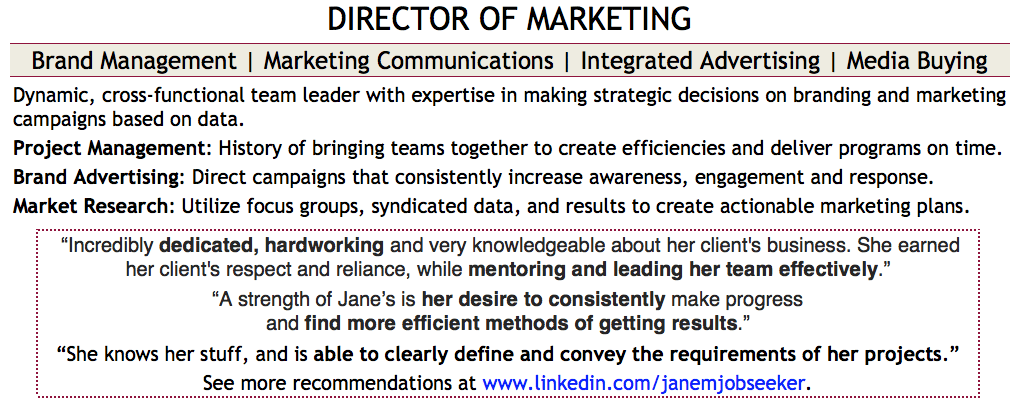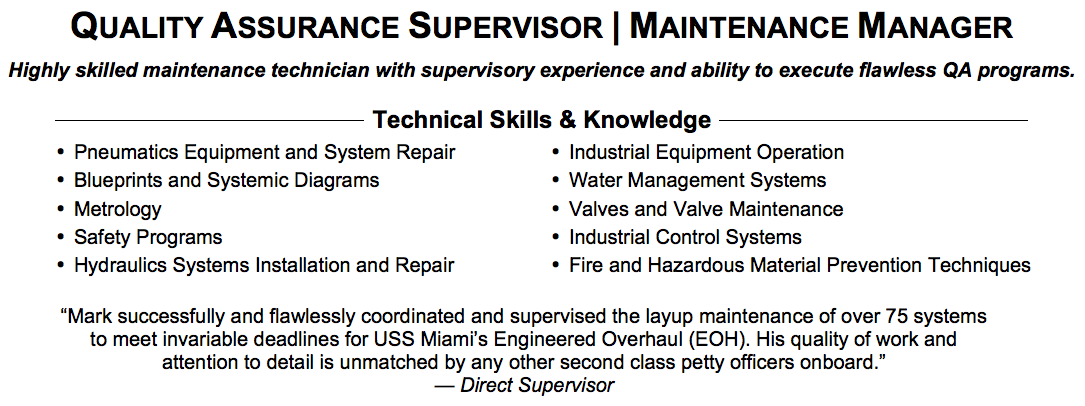
Now that you have a professional looking header for your resume, we’re going to focus on the most critical part of your resume, the summary or professional profile section. You should think of the summary section of your resume as your 10-second elevator pitch. Yep, 10 seconds. That is about the most time a hiring manager will look at your resume to decide if they should read on or not.
Think Like a Journalist
The top third of your resume is much like the front page of a newspaper. You have a masthead, your header, and then you have a headline to draw readers in to the story.
On your resume instead of titling the summary section, Summary or Executive Profile, use your current or targeted job title instead. Hiring managers will be able to see right away what you want.
Then you can follow the headline with a subhead that either speaks to your industry expertise, or makes a personal branding statement. Here is an example of a senior-level salesperson targeting the digital marketing industry:
Bonus Tip: When creating the version of your resume to use for online applications, do use the title of Summary for this area. Applicant Tracking Systems (ATS) like to have standard headings so they can interpret the content properly.
Objectives are Out, Value Propositions are In
The traditional objective statement of yesteryear should not be used on a resume today. Traditional objective statements were very focused on the candidate and not the employer. Here is an objective statement I just had to share because it is so poor in multiple ways.
This example is poor for the following reasons:
- It uses the first person preposition, “I”, “me” and “my” which just proves this statement is all about the candidate.
- It is not specific in any way. It does not state the type of position or the type of educational background the candidate has.
- There is nothing unique about it, so it could apply to any human being looking for any job.
Instead of an objective statement, think value proposition. I always say to my clients, “Do not tell the company what you want from them, show the company what you can do for them.” You can show them by highlighting the skills you’ve mastered at prior positions, and you have a few options to accomplish this. Let’s look at our account executive example:
Here, the candidate’s skills are highlighted as well as some specific examples to support those skills. Another way to “show” your value is to include some quotes from your LinkedIn recommendations or even your past job reviews. Below is an example of that.
Bulleted List of Skills – To Include or Not to Include?
The last component that can go into a summary section is a list of skills that you have expertise in. I will be honest in telling you that there has been some recent debate within the resume writing community on whether or not to include a list like this. So, I will give you the pros and cons of including a bulleted list of skills.
PROS
- Gives you an easy opportunity to include keywords.
- It can be scanned quickly.
CONS
- It doesn’t add any substance to the skills.
- Everyone is doing it, so you don’t stand out as much.
Personally, I am on the fence as whether or not to include a list, and like to say it depends on the situation. If the person is applying for a technical job where mastery of certain programs or machinery is critical, then I would lean towards including a list. If the candidate is using the list to highlight more soft skills, I would lean towards not including the list because these skills can better be addressed within the context of the resume – either the summary or experience sections.
Below is an example of a more technical position with a list of technical skills within the summary as well as a quote from a review.
What elements are you going to include in the summary section of your resume? Let us know in the comments below. If you have questions about what to include in the summary section of your resume, let us know, and we can help. Stay tuned for next week’s installment of this series, How to Write a Great Resume, Part 3 of 4 — Work Experience.
Image courtesy of David Castillo Dominici / FreeDigitalPhotos.net.






